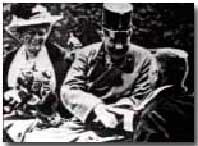 World War I was also known as “The War to End all Wars”. The underlying cause was the increasing economic and military competition between Britain and Germany; the spark that ignited it was the assassination of Archduke Franz Ferdinand, heir to the Austro-Hungarian throne, in Sarajevo, in June 1914; by the Black Hand, a Serbian nationalist secret society.
World War I was also known as “The War to End all Wars”. The underlying cause was the increasing economic and military competition between Britain and Germany; the spark that ignited it was the assassination of Archduke Franz Ferdinand, heir to the Austro-Hungarian throne, in Sarajevo, in June 1914; by the Black Hand, a Serbian nationalist secret society.
Austria-Hungary’s reaction to the death was to demand Serbia not only bring the assassins to justice, but also renounce her sovereignty. Austria-Hungary’s expectation was that Serbia would reject the demand, thus giving her a pretext for launching a limited war against Serbia, which it did in July 1914. However because of existing alliances, that single action brought virtually the entire western world to war.
The Serbians had a defense treaty with Russia, but The Entente Powers included Russia, France, and the United Kingdom. Japan, honoring a military agreement with Britain, declared war on Germany in August. Italy joined the allies in April 1915. The Central Powers, so named because of their central location on the European continent, consisted of Germany and Austria-Hungary. The Ottoman Empire joined the Central Powers in October, followed a year later by Bulgaria. By the end of the war, only The Netherlands, Switzerland, Spain and the Scandinavian nations remained officially neutral. The US also remained neutral until 1917 when German unrestricted submarine warfare seriously threatened America’s commercial shipping and forced the U.S. to enter the war in April 1917.
The war took place on several fronts across the Europe. The Western Front was marked by a system of trenches, and breastworks stretching 475 miles and precipitated a style of fighting known as trench warfare.
By the autumn of 1918, with revolution imminent, Germany petitioned for an armistice. It took effect at 11am on November 11 – the eleventh hour of the eleventh day of the eleventh month. The war was formally ended by several treaties, most notably the Treaty of Versailles, signed on 28 June 1919.
One of the striking outcomes of the war was the end of a world order which had existed since the Napoleonic Wars and the wholesale redrawing of the map of Europe. All of the Central Powers lost territory, and many new nations were created. The German Empire lost its colonial possessions. The Austro-Hungarian and Ottoman empires were completely dissolved. Austria-Hungary was carved up into several successor states including Austria, Hungary, Czechoslovakia, and Yugoslavia. The Ottoman Empire disintegrated, and much of its non-Anatolian territory was awarded as protectorates of various Allied powers, while the remaining Turkish core was reorganized as the Republic of Turkey. The Russian Empire, which had withdrawn from the war in 1917, lost much of its western frontier as the newly independent nations of Estonia, Finland, Latvia, Lithuania, and Poland were carved from it. After the war, the League of Nations was created as an international organization designed to avoid future wars by giving nations a means of solving their differences diplomatically.
